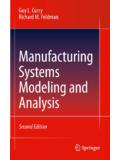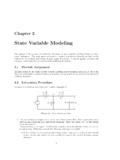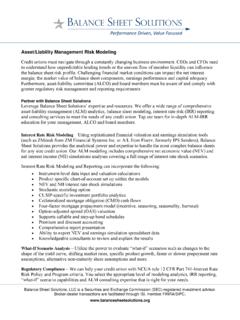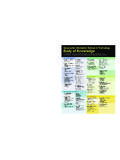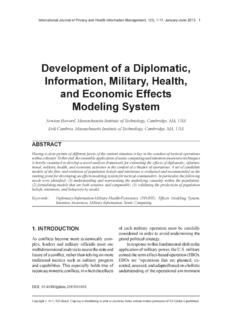Transcription of Introduction to DESr - ALBRECHTS.COM
1 I Introduction to Discrete Event simulation By M. C. (Mike) Albrecht, (AZ) January 2010 Table of Contents Introduction .. 4 Selecting simulation and modeling 6 6 simulation 6 Software Selection Frameworks .. 7 New Generation modeling Framework (Page 1994) .. 8 simulation checklist (Hlupic, Irani, and Paul 1999) .. 17 Selection of simulation software (Banks and Gibson 1997) .. 18 simulation Evaluation Criteria (Ahmed, Hall and Wernick 2003).. 20 21 modeling Package Evaluation .. 22 modeling Environment .. 23 Model Structure .. 27 Taxonomy, Ontology, and Formalism .. 27 Taxonomy .. 28 29 Comparison of 29 Resource-Driven versus Job-Driven .. 32 43 Model Specification (Formalism).
2 48 Defining a Model 49 Verification & 49 Experimentation 57 Statistical Facilities .. 57 Statistical Analysis .. 57 Random Number Generation .. 63 User support .. 65 Financial and technical features .. 65 65 modeling Package Evaluation 66 Arena .. 66 Extend .. 68 Sigma .. 69 Ptolemy 70 Analysis .. 71 ii simulation in Decision Support .. 72 DES in Decision Support .. 75 Equipment Sizing Of A Material Handling 76 Project Definition .. 78 simulation Results .. 80 Decision Support System for Process Changeover .. 81 83 System Operation .. 87 Results .. 89 Hybrid simulation .. 91 Stochastic/DES .. 92 92 A Combined Analytical DES Model ..93 Worked Hybrid Example.
3 101 simulation and modeling for Complex systems .. 107 Potential Research 108 Operations Control .. 108 Model/DSS Reusability .. 109 Hybrid simulation in real world applications.. 109 Appendix A: Current (2007) simulation Software ..111 Appendix B: simulation Software Evaluation I .. 114 Appendix C: simulation Software Evaluation II .. 124 Appendix D: modeling Package Table of Figures Figure 1: Illustration of Event, Activity and Process. (Page (1994)) .. 10 Figure 2: Machine Repairman ACIG .. 30 Figure 3: Event Scheduling ACIG .. 31 Figure 4: Activity Scanning ACIG .. 31 Figure 5: Process Interaction 32 Figure 6: Model 1(CARWASHA1): .. 40 Figure 7: Model 2 (CARWASHB1).
4 40 Figure 8: Graphical representation of the rationale behind DeMO 47 Figure 9: Time in 62 Figure 10: Batched Sample Results Time in 62 Figure 11: Generic Expert System .. 74 Figure 12: Initial Process Flow 78 Figure 13:SIGMA Event Graph Model .. 80 Figure 14: MS Project Schedule for Base Side to Acid Side 82 Figure 15: Network Analysis of H2 Process Changeover (SIGMA organization) .. 86 Figure 16: System Access Screen .. 87 Figure 17: Event & Tasks 88 Figure 18: simulation run Screen .. 89 Figure 19: Output results Table and Changeover 90 Figure 20: Hybride simulation 95 Figure 21: Sigma Model for MPLP Problem .. 103 iii Figure 22: Production Time by Product.
5 103 Figure 23: Alternative Schedules .. 105 Table of Tables Table 1: Requirements for a Next-Generation modeling Framework .. 14 Table 2: DES Methodology 15 Table 3: Comparison of the job-driven and resource-driven paradigms .. 33 Table 4: Comparison of the implementation 33 Table 5: SPL's by 34 Table 6: SPL's by 35 Table 7: simulation run lengths for the fab model .. 37 Table 8: Model 1 (Carwash A1).. 41 Table 9: Model 2 (CarwashB1).. 41 Table 10: Model 1 (Carwash A1): 42 Table 11: Model 2 (CarwashB1) 42 Table 12: Use of Ontologies by 43 Table 13: A Framework For Assessing The Credibility Of A 55 Table 14: CLT check using Carwash 61 Table 15: LCG periods.
6 63 Table 16: modeling Package Evaluation Results .. 72 Table 17: Process Design 79 Table 18 : simulation 80 Table 19: changeover Event and Task List .. 84 Table 20: Cost components .. 96 Table 21: 96 Table 22: Process 96 Table 23: Process Routings .. 96 Table 24: Hybride Example Iteration Results .. 106 4 Introduction In my studies in Industrial Engineering/Operation Research, I became very interested in Discrete Event simulation (actually I became interested in simulation back in my undergraduate work, but that is another story). I was preparing a research proposal on this area, when for several reasons I decide not to continue at this time (hence the Masters of Engineering).
7 So that my work would not go to waste, I have created this site to make the work available to others. What is Discrete Event simulation (DES)? In classical thinking there are three types of simulation ; discrete event, continuous, and MonteCarlo. In current thinking and work, these lines are becoming less distinct. DES (based on Nance (1993)) is a model (mathematical and logical) of a physical system that has changes at precise points in simulated time. Customers waiting for service, the management of parts inventory or military combat are typical types of DES. This site has it s emphasis on discrete event simulation (DES), but does include information on decision support systems (DSS) (particularly how DES can be used in DSS).
8 This site will try to present an overview of DES as a tool. Particular emphasis will be on the use of DES in engineering decision support. The following topics are covered in on this site: Selecting a simulation and modeling Language Evaluating a simulation and modeling Package Using Discrete Event simulation in Decision Support What is Hybrid simulation I have also include a general Bibliography and a more focused Annotated bibliography that was used in preparing this site. So again, What is Discrete Event simulation (DES) ? In classical thinking there are three types of simulation ; discrete event, continuous, and MonteCarlo. They were articulated by Nance (1993) as: 5 Discrete event simulation utilizes a mathematical/logical model of a physical system that portrays state changes at precise points in simulated time.
9 Both the nature of the state change and the time at which the change occurs mandate precise description. Customers waiting for service, the management of parts inventory or military combat are typical domains of discrete event simulation . Continuous simulation uses equational models, often of physical systems, which do not portray precise time and state relationships that result in discontinuities. The objective of studies using such models do not require the explicit representation of state and time relationships. Examples of such systems are found in ecological modeling , ballistic reentry, or large scale economic models. Monte Carlo simulation , the name given by John van Neumann and Stanislaw M.
10 Ulam to reflect its gambling similarity, utilizes models of uncertainty where representation of time is unnecessary. The term originally attributed to "a situation in which a difficult non-probabilistic problem is solved through the invention of a stochastic process that satisfies the relations of the deterministic problem". A more recent characterization is that Monte Carlo is "the method of repetitive trials. Typical of Monte Carlo simulation is the approximation of a definite integral by circumscribing the region with a known geometric shape, then generating random points to estimate the area of the region through the proportion of points falling within the region boundaries.

